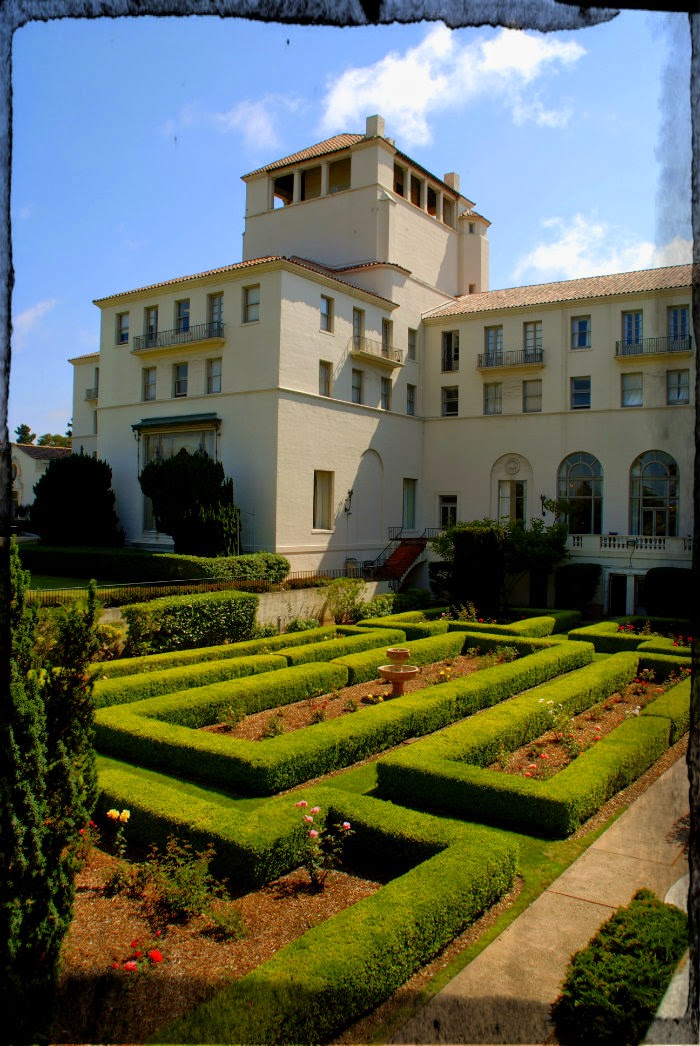 |
| 2013 Steinbeck Institute participants pictured at Pacific Biological Laboratories on Cannery Row. |
This blog has been designed with educators and students in mind, but it is certainly a valuable resource for anyone with a keen interest in the collected works of John Steinbeck.
Cannery Row is Steinbeck’s attempt to holistically recreate his Monterey, California and his personal experiences in the place at a specific time. While no depiction of life can be truly all inclusive, Cannery Row is Steinbeck’s valiant attempt to capture “ a poem, a stink, a grating noise, a quality of light, a tone, a habit, a nostalgia, a dream” for the reader that, to the best of his ability, encapsulates the mystique and vitality of an environment that he loved dearly in his own lifetime (1).
This blog, lovingly assembled by a participant of the 2013 Steinbeck Institute, is a collection of photos that were amassed during the NEH funded program. All of the photography on this blog, unless otherwise indicated, is original source material. Programs like the Steinbeck Institute make projects like this possible.
How is this resource organized?
Cannery Row is made up of a preface and 32 chapters. This blog proceeds chronologically through the book with a photo-based entry for each of the 33 entries made by Steinbeck. Great care was taken to mindfully place photos, music (links at the end of various entries), and artwork that would enhance a reader's experience. Reading is one thing; seeing while reading is another thing entirely... for educators with students who struggle to visualize setting, scenery, and characters, this resource should prove to be invaluable throughout the teaching process.
How should I use this resource?
My suggestion is that you utilize these photos in tandem with the Google-based document I created (key vocabulary, chapter summaries, and suggested activities) and the 5 specific lesson plans I built after attending the institute. View the shared folder and my Cannery Row instructional resources HERE.
What grade levels and classes is this material appropriate for?
Cannery Row is an overlooked gem. For secondary English teachers like myself, class time is at an all-time premium. With monstrous state standards, common core requirements, AP/IB/Honors/Interdisciplinary exams to worry about, it can be difficult to "squeeze" in books, especially "risky" new books. Unlike some of John Steinbeck's more lengthy tomes (which I highly recommend as well!), Cannery Row clocks in at approximately 180 pages. Each chapter could technically stand alone as a short story. There is an underlying narrative. There are cool philosophically-driven "inner" or intercalary chapters for socratic seminars and philosophical chairs activities... I teach this book to Honors 9th graders but I think it has a place in any American literature course--or even, dare I say, an ecology or biology classroom!
First things first. Read (or re-read) the book... come on... I dare you!
I don't have much time. What should I do?
Most teachers don't have time for "additional" texts in our terrifyingly fast paced and increasingly standards driven lives. Cannery Row is comprised of a preface and 32 chapters. If a teacher was short on time, they could simply skip the majority of Steinbeck's "inner" or intercalary chapters (these are marked in the blog as [inner] prior to the chapter title) and focus on the main narrative and characters. Please see the document in my Google drive folder HERE called "schedules" for suggested pacing and abbreviated lesson ideas. This could easily be a component of a "short story" unit...
The book seems cool, but what good is it to my students?
Cannery Row IS life... students, once properly primed, respond to the characters and situations in this book with energy and enthusiasm. I require my students to create a Blogger account though Gmail (our school system uses "G" accounts for each student) and respond to a prompt of some sort for each chapter or set of assigned chapters. See the file called "Vocab, chapter summaries, and suggested activities" HERE for my dialectical blog/journal activity ideas. I skip a few, given time constraints, but students are required to respond to the text (annotating and also reflecting) each time they have assigned readings. I find making the writing assignments about "them" (my students) creates powerful content. Reading this book is a community building event!
“If a story is not about the hearer he [or she] will not listen . . . A great lasting story is about everyone or it will not last. The strange and foreign is not interesting--only the deeply personal and familiar.”
-John Steinbeck, from East of Eden
What is up with the chapter names? Steinbeck just uses numbers!
Yep. I "titled" each of the 32 chapters as I closely reread the book while constructing this site. These are not "official" titles but I find them easier to refer to and remember with the titles. Take them, change them, suggest alternatives, whatever! Just use this!
Do you know of any other Steinbeck resources?
Start here:
The Steinbeck Institute
San Jose State University - Steinbeck
National Center for Steinbeck Studies
NEH Steinbeck Lesson Plans
Blogs from Steinbeck Institute participants:
Mark Miazga's Blog: Epiphany in Baltimore
Dan Clare's Blog: Steinbeckia
To close, I'd like to warmly acknowledge the many fine individuals who made this project possible--specifically Susan Shillinglaw, William Gilly, Maria Judnick, Charlie, and all of my 2013 Steinbeck Institute colleagues. Ad astra per alia porci!

















































